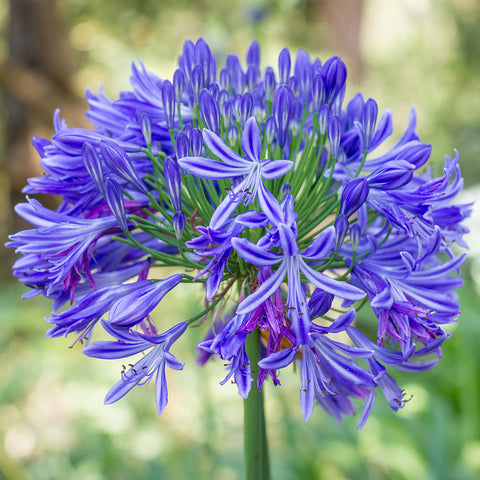Seasonal Agapanthus Care: Planning For Wintertime and Summer
Seasonal Agapanthus Care: Planning For Wintertime and Summer
Blog Article
Releasing the Secret to Effective Agapanthus Growing: Tips and Techniques for a Flourishing Yard
In the realm of horticulture, cultivating agapanthus efficiently requires a critical technique that encompasses numerous aspects of plant treatment. By understanding the subtleties of agapanthus cultivation, one can develop an atmosphere where these plants grow and bloom perfectly.
Planting Agapanthus: Finest Practices
When growing Agapanthus, correct dirt preparation is crucial for making sure effective growth and advancement of these attractive flowers. Agapanthus, commonly called Lily of the Nile or African lily, thrives in well-draining dirt with a slightly acidic to neutral pH degree - Agapanthus. Prior to growing, it is important to modify heavy clay soils with natural issue such as garden compost or peat moss to improve drain and provide necessary nutrients for the plants
To plant Agapanthus, select an area that gets complete sunlight to partial color, as this will certainly promote healthy and balanced development and abundant blooming. Dig an opening twice the diameter of the plant's origin ball and put the Agapanthus at the very same depth it was previously expanding. Delicately backfill the hole with soil, pushing down strongly to remove any air pockets around the roots.
Water the recently grown Agapanthus extensively and remain to maintain the dirt evenly moist, especially throughout the plant's energetic expanding season. Agapanthus. Applying a balanced plant food once a month can further support the plant's growth and flowering. By complying with these finest methods for growing Agapanthus, you can produce a stunning screen of these fascinating blossoms in your garden
Suitable Soil Conditions for Agapanthus
For optimum development and blooming success of Agapanthus plants, ensuring the dirt problems are suitable is critical. Agapanthus thrives in well-draining soil with a somewhat acidic to neutral pH level ranging from 6.0 to 7.0. This sort of dirt permits for appropriate water drain, avoiding waterlogging which can result in root rot. To boost dirt drain, think about adding raw material such as compost or peat moss when preparing the planting site. Moreover, Agapanthus favors dirt that is rich in nutrients, so incorporating a balanced plant food throughout the expanding season can promote healthy development and vivid blossoms.

Watering and Fertilizing Tips
To ensure healthy and balanced development and go dynamic blooms, correct watering and fertilizing strategies are crucial for effective Agapanthus growing. Agapanthus plants benefit from normal watering, specifically during the growing season.
When it concerns feeding Agapanthus, a balanced fertilizer with equivalent parts nitrogen, phosphorus, and potassium can be used in the springtime to promote healthy and balanced development and blooming. Slow-release fertilizers are ideal for providing nutrients progressively over a prolonged period. Avoid over-fertilizing, as this can bring about extreme foliage development at the cost of flowers.
Furthermore, incorporating raw material like compost right into the soil can boost nutrient levels and boost Get the facts soil framework, helping in the overall wellness of the Agapanthus plants. By following these watering and feeding tips, garden enthusiasts can guarantee their Agapanthus plants flourish and produce magnificent screens of flowers.
Trimming and Deadheading Techniques
Correct pruning and deadheading strategies play an important role in preserving the wellness and aesthetic appeals of Agapanthus plants, enhancing the important techniques of watering and fertilizing for successful growing. Pruning Agapanthus includes getting rid of spent blossom heads, dead or yellowing fallen leaves, and overall shaping of the plant to promote far better growth. Deadheading, the procedure of removing faded blossoms, not just improves the plant's look but also motivates more blooming.
When deadheading Agapanthus, it is a good idea to snip off the flower stem at the base utilizing sharp, tidy shears. This procedure reroutes the plant's power from seed manufacturing back right into origin and foliage growth, promoting a much healthier and more robust plant. Routine deadheading can expand the growing period of Agapanthus and avoid self-seeding, which can cause congestion.
In terms of trimming, Agapanthus generally take advantage of a light trim after flowering to clean up the plant and encourage fresh development. Reducing the invested blossom stems and getting rid of any kind of dead or broken foliage helps maintain the plant's vigor and overall look. Nonetheless, it is vital to stay clear of reducing right into the crown of the plant, as this can deteriorate its health and wellness.

Protecting Agapanthus From Pests and Diseases
Executing reliable insect and condition administration approaches is important to guarding the health and vigor of Agapanthus plants in growing. One usual bug that affects Agapanthus is the Agapanthus borer, a caterpillar that tunnels right into the plant, causing damages to the flowers and fallen leaves.
In addition to pests, Agapanthus are susceptible to diseases such as root rot and fungal fallen leave places. By remaining vigilant and addressing pest and illness issues promptly, gardeners can aid their Agapanthus thrive and thrive.

Conclusion
Finally, successful farming of agapanthus requires correct planting strategies, optimal soil problems, adequate watering and fertilizing, routine trimming and deadheading, and protection from insects and conditions. By complying with these techniques and pointers, gardeners can guarantee a prospering yard More hints loaded with stunning agapanthus blossoms. Agapanthus. Bear in mind to maintain consistent care and interest to information to advertise the health and longevity of these spectacular plants
When growing Agapanthus, correct dirt prep work is essential for guaranteeing successful development and advancement of these attractive blossoms.Water the freshly grown Agapanthus thoroughly and continue to keep the soil uniformly damp, particularly during the plant's active growing season.For ideal growth and flowering success of Agapanthus plants, making sure the dirt conditions are optimal is vital. When growing or hair transplanting Agapanthus, ensure the soil is well-prepared to provide the required foundation for the plants to establish themselves successfully. One usual parasite that influences Agapanthus is the Agapanthus borer, a caterpillar that passages into the plant, triggering damage to the leaves and flowers.
Report this page